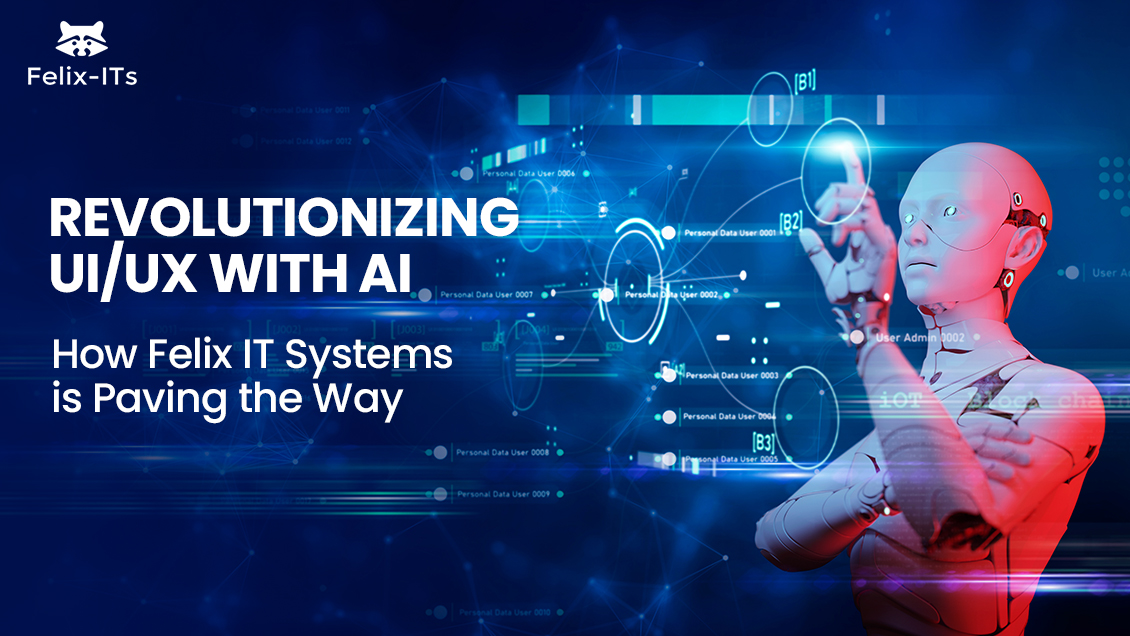Introduction
In the ever-evolving world of technology, the intersection of Artificial Intelligence (AI) and UI/UX design is creating ground-breaking opportunities. The integration of AI in UI/UX not only enhances user experience but also redefines how designers approach problem-solving. In this comprehensive guide, we delve into how AI is transforming the UI/UX landscape and the pivotal role Felix IT Systems plays in equipping aspiring designers with the necessary skills to thrive in this innovative field.
The Convergence of AI and UI/UX Design
AI’s role in UI/UX design is multifaceted, offering unparalleled precision and efficiency. By analyzing large datasets, AI can predict user behavior, enabling designers to create more intuitive and personalized user experiences. This technology also automates routine tasks, allowing designers to focus on more creative aspects. For instance, AI can optimize layouts and color schemes based on user preferences, or even generate design prototypes. This synergy of AI and UI/UX is not just about enhancing aesthetics; it’s about crafting experiences that are deeply aligned with user needs and expectations.
Will AI Replace UX Designers? Here’s Why It’s Unlikely
UX design will most probably continue to be done by humans, for its completion—with AI assisting in relatively mundane online tasks like the analysis of user data, repeated tasks, and layout suggestions. But when out-of-the-box, human-centric, and strategic thinking must be coupled with empathy in design, AI will make errors in the practice of design.
The work of a UX designer is essentially based on understanding how people feel and behave and responding accordingly to build experiences that are intuitive and meaningful—qualities elusive to AI, at least at present.
Here’s a breakdown of why AI won’t replace UX designers and the skills they bring that AI can’t replicate:
- Creativity and Innovation– Designers use their imaginations to create a distinctive user-friendly idea or solution that digs deeper than the surface analysis of data.
- Strategic Thinking– UX designers keep the final user in mind along with the business goals and long-term effects anticipated as well as ethical implications that AI tools can never comprehend fully.
- Human-Centered Problem Solving– Designers decipher and respond to subtle cues of the user and use moves that help create the best intuitive experiences.
- Storytelling and Communication– UX designers try to spin stories and say things that tie up the users with the essence and values of the mission in the hands of the brand, normally establishing a sense of trust and engagement.
Additional Read – How to Successfully Land a UX/UI Design Internship
How Not to Use AI in UX Design: Key Pitfalls to Avoid
Bringing AI into UX means inviting you not to fall into potential pitfalls. Here are a few ways AI should not be used in UX and how to use it to help ensure a positive user experience:
- Over-Automating User Experience: Costing too much time on AI to interact with users disengages it. Instead of automatically operating, designers should seamlessly combine AI with human touches whenever applicable.
- Ignoring Privacy: Do not target a subtle level of data collection to receive user consent. Invasive data harvesting can harm trust; ensure that transparency is prioritized and that you respect users’ privacy across all the stages.
- Substituting Data for Empathy: AI indicates user patterns; it cannot empathize. Never blindly make decisions solely on AI insights; human feedback and intuition are imperative to understanding user needs.
- Ignoring Accessibility: AI features can be difficult to access for some users. Therefore, don’t insert intricate AI that could exclude the likes of a user group with disabilities or those who access the services using bandwidth-sensing devices.
- Putting too much trust in the automatic suggestions of an AI tool: AI tools can think of design ideas; never let the tools duke it out against human creativity. Ultimately, designers should always be central to building unique, brand-aligned experiences.
AI-Driven Design: The Future of UI/UX
The future of UI/UX lies in harnessing AI to create designs that are both aesthetically pleasing and functionally superior. AI’s ability to process vast amounts of user data means designs can be continuously refined to suit changing preferences. Moreover, AI-driven analytics provide invaluable insights into user engagement, helping designers make informed decisions. This approach ensures that UI/UX design remains dynamic, adaptive, and user-centric.
Bonus Read – Level Up Your UI/UX Skills: AI-Focused Online Courses for Designers
Felix IT Systems: Leading the AI Revolution in UI/UX Design
At Felix IT Systems, we recognize the transformative potential of AI in UI/UX design. Our courses are meticulously structured to blend traditional design principles with cutting-edge AI technologies. Students at Felix IT Systems gain hands-on experience with AI tools, learning to leverage them for creating innovative design solutions. Our curriculum covers AI fundamentals, its application in UI/UX, and the latest industry trends. By focusing on practical skills and real-world applications, we ensure our graduates are not just ready for the present but are also equipped to lead the future of design. Our expert instructors, who are industry veterans, provide insights into how AI is reshaping the design landscape, preparing our students to be at the forefront of this revolution.
Conclusion
Embracing AI in UI/UX design is not just a trend; it’s a strategic move towards the future of digital interactions. Felix IT Systems stands as a beacon for those aspiring to master this integration, offering a gateway to becoming pioneers in this exciting and evolving field.
Step into the future of UI/UX design with AI. Join Felix IT Systems’ innovative courses and become a part of this exciting revolution. Enroll Now and Transform Your Design Career.


